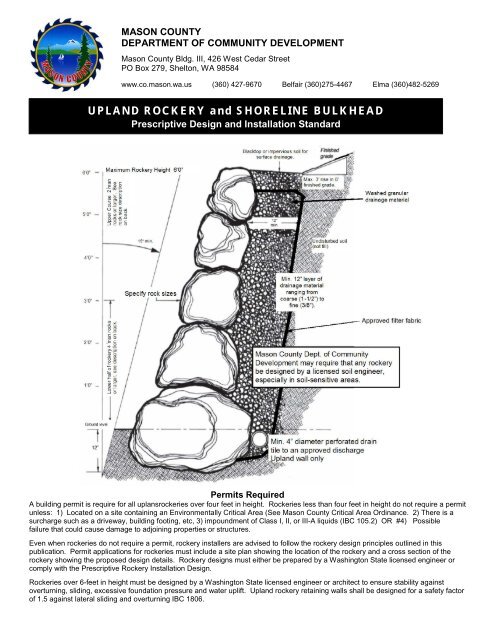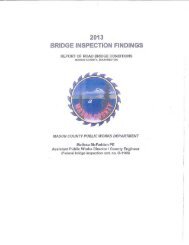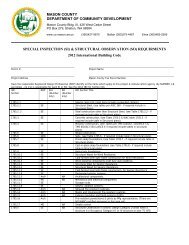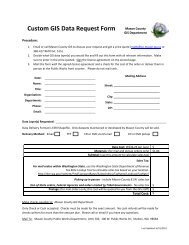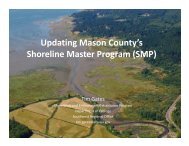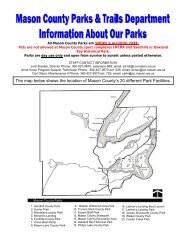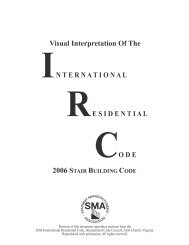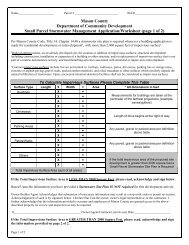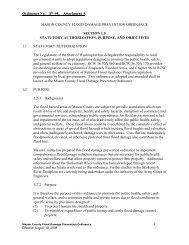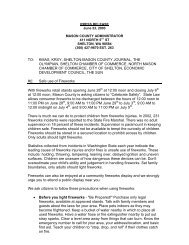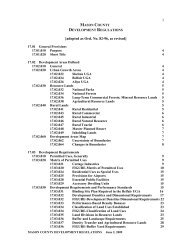UPLAND ROCKERY - Mason County
UPLAND ROCKERY - Mason County
UPLAND ROCKERY - Mason County
You also want an ePaper? Increase the reach of your titles
YUMPU automatically turns print PDFs into web optimized ePapers that Google loves.
MASON COUNTY<br />
DEPARTMENT OF COMMUNITY DEVELOPMENT<br />
<strong>Mason</strong> <strong>County</strong> Bldg. III, 426 West Cedar Street<br />
PO Box 279, Shelton, WA 98584<br />
www.co.mason.wa.us (360) 427-9670 Belfair (360)275-4467 Elma (360)482-5269<br />
riptive Design <strong>UPLAND</strong> and Installation <strong>ROCKERY</strong> Standard<br />
SHORELINE BULKHEAD<br />
Prescriptive <strong>UPLAND</strong> Design and <strong>ROCKERY</strong><br />
Installation Standard<br />
Pre<br />
scriptive Design and Installation Standard<br />
Permits Required<br />
A building permit is require for all uplansrockeries over four feet in height. Rockeries less than four feet in height do not require a permit<br />
unless: 1) Located on a site containing an Environmentally Critical Area (See <strong>Mason</strong> <strong>County</strong> Critical Area Ordinance. 2) There is a<br />
surcharge such as a driveway, building footing, etc, 3) impoundment of Class I, II, or III-A liquids (IBC 105.2) OR #4) Possible<br />
failure that could cause damage to adjoining properties or structures.<br />
Even when rockeries do not require a permit, rockery installers are advised to follow the rockery design principles outlined in this<br />
publication. Permit applications for rockeries must include a site plan showing the location of the rockery and a cross section of the<br />
rockery showing the proposed design details. Rockery designs must either be prepared by a Washington State licensed engineer or<br />
comply with the Prescriptive Rockery Installation Design.<br />
Rockeries over 6-feet in height must be designed by a Washington State licensed engineer or architect to ensure stability against<br />
overturning, sliding, excessive foundation pressure and water uplift. Upland rockery retaining walls shall be designed for a safety factor<br />
of 1.5 against lateral sliding and overturning IBC 1806.
Rockery and Shoreline Bulkhead<br />
Height: Maximum Six Feet<br />
Rockeries installed in accordance with the prescriptive installation design standards described here and reflected in the<br />
diagram need not be designed by an engineer unless the <strong>Mason</strong> <strong>County</strong> Building Dept. determines special conditions<br />
exist. Any rockery exceeding six feet in height or varying from the prescriptive design requires an engineered design.<br />
Location of Rockery<br />
Rockeries must only be placed against stable slopes, consisting of firm, undisturbed soil. The face of the slope needs to<br />
be able to support the rockery. Drainage must be provided as shown. Rockeries must not be placed against fill. No<br />
surcharge load, such as a building or driveway, may be placed on the rockery or within a distance equal to the vertical<br />
height of the rockery.<br />
Ground Surface Above Rockery<br />
The ground surface above the rockery should be relatively level. A maximum three foot rise over eight feet from the<br />
rockery surface is allowed for the slope above the rockery. After installation of the rockery, the ground surface above the<br />
rockery should be finished with an impervious material, such as asphalt, starting at the top of the rockery and extending at<br />
least far enough back to cover the drainage material plus one foot of the stable, supporting slope.<br />
Angle of the Rockery Face<br />
The face of the rockery shall be at least 15 degrees from the vertical. Maximum slope of the face of the rockery is one<br />
horizontal to four vertical.<br />
Rock Sizes<br />
For a rockery between four and six feet in height, the prescriptive standards requires that the lower half be constructed of<br />
four-man or larger rocks (defined below). For the upper half, progressively smaller rocks may be used in the installation.<br />
ROCK SIZE DESCRIPTION<br />
Rock Size Rock Weight Average Dimension<br />
1-man 50-200 lbs. 12”-18”<br />
2-man 200-700 lbs. 18”-28”<br />
3-man 700-2,000 lbs. 28”-36”<br />
4-man 2,000-4,000 lbs. 36”-48”<br />
5-man 4,000-6,000 lbs. 48”-54”<br />
6-man 6,000-8,000 lbs. 54”-72”<br />
Rock Placement<br />
The base course of rocks must be embedded into firm undisturbed earth to a minimum depth of 12 inches to provide a<br />
secure footing for the rockery. The long dimension of the rocks must extend into the slope behind the rockery to provide<br />
maximum stability. Subsequent courses of rocks must be placed to lock into the rocks in the lower course or tier.<br />
Drainage<br />
A minimum of 12 inches of washed granular drainage material shall be placed between the undisturbed soil and the<br />
rockery. The drainage materials must be composed of gravel with particle sizes ranging from 1-1/2 inch to 3/8 inch. At<br />
the base of the rockery, a perforated drain tile, with at least a four-inch diameter, shall be installed within the drainage<br />
materials. The drain tile must drain to a point of discharge, approved by <strong>Mason</strong> <strong>County</strong>.<br />
Inspections<br />
The rockery installer must schedule an inspection prior to placement of the base course so the <strong>Mason</strong> <strong>County</strong> Inspector<br />
may verify the rockery height, soil condition, rock size, and provisions for drainage, A final inspection is also required<br />
once all work is complete. To schedule an inspection call the <strong>Mason</strong> <strong>County</strong> 24-hour recorded inspection request line at<br />
(360)427-7262. Inspections can also be requested online at: www.co.mason.wa.us or by fax at (360) 427-7798. When<br />
requesting an inspection please provide the following information:<br />
1) Name on permit 2) type of inspection 3) Permit number<br />
4) Site Address 5) Type of permit 6) Date inspection requested and<br />
7) Name and phone number of caller.<br />
Effective November 17, 2004


